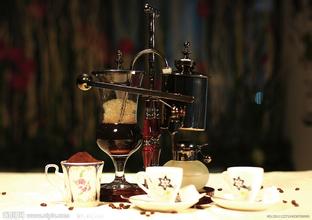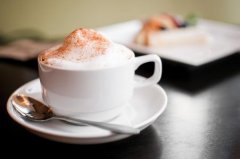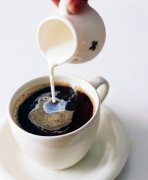Coffee making process the elements of making a good cup of coffee

The elements of making a good cup of coffee:
a. It is necessary to have very good coffee ingredients, that is, coffee beans.
b. Have good and suitable coffee equipment
c. People who make coffee should have the correct method of operation.
one。 Coffee knowledge
The two common coffee varieties in the market are Arabica Coffee and Robesda Coffee. "
In terms of growth environment, Arabica coffee grows on high slopes, and Robesda coffee can grow in plain areas. The yield of Arabica coffee is relatively low because of the limited growth environment. Robesda's yield is relatively high, which determines the difference between the two.
In terms of picking methods, Robesda coffee can be picked mechanically because it is grown in plain areas, while Arabica coffee can only be picked by coffee farmers because it is planted on sloping land. Because of the different picking costs, the two prices are different.
In terms of caffeine content, Arabica coffee has lower caffeine content than Robesda coffee. Because caffeine itself has a certain anti-pest effect, Arabica coffee is easily eroded by diseases and insect pests, which will also affect the yield.
In terms of taste, because caffeine itself presents a bitter and astringent taste to the taste senses, Arabica coffee has a lighter bitter taste, while Robesda coffee has a heavier bitter taste.
In terms of the processing methods after picking, the processing methods of the two kinds of coffee after ripening and picking are different. The method used to remove the pulp of Robesda coffee is "air-drying". This method is generally through mechanized picking, one-time picking of mature coffee beans and immature coffee beans, and then spread in the drying ground for drying, so that the flesh is naturally air-dried, and then peeled. The advantage of this processing method is that it has a large processing capacity at one time. The disadvantage is that in the process of air-drying, because the coffee fruit is in direct contact with the ground, it will absorb part of the moisture and odor, which will affect the quality of coffee, and the quality of coffee beans is different when picking, so this method is not suitable for processing high-quality coffee. On the other hand, Arabica coffee is picked by coffee farmers on seven to eight rounds in the coffee garden during the mature period, and only mature coffee is picked each time. Peel off the outer pulp of the picked coffee directly through the washing machine, which virtually ensures the quality of the coffee, but the disadvantage is that the disposable coffee is processed less and the processing cost is higher.
Combining the respective characteristics of the above two coffee varieties, it directly determines the difference in their price and quality.
Yunnan's Robster coffee is 7 yuan per kilogram and Arabica coffee is 70 yuan per kilogram.
The roasting of coffee is generally divided into eight stages, of which light roasting accounts for two stages, moderate baking and deep roasting each account for three stages. From the color point of view, the light white color belongs to light baking, the red brown color belongs to moderate baking, and the black surface bright oil belongs to deep baking also called heavy baking. You can choose different roasting degrees of coffee according to your taste, because the heavier the roasting, the heavier the taste.
After the roasted coffee is ground into coffee powder by various forms of bean grinder, the coffee can be extracted with different coffee brewers.
After roasting at high temperature, the coffee needs 48 hours of natural breathing before its fragrant ingredients can reach the ideal state. In order to keep the ideal condition, it is necessary to consider the problem of packaging and preservation.
Newly picked raw beans should be stored for a period of time before they can have better quality, but once cultivated, they should be carefully preserved or it will seriously affect the aroma. In general, the shelf life of sealed aluminum-platinum bags is three months. The shelf life of ordinary packaging without Sui gas is one month, and the packaging with nitrogen can be kept fresh for two to three years.
Coffee beans lose 20% of their fragrance immediately after the sachet is broken during grinding. So coffee powder is more difficult to preserve than coffee beans.
The dryness of coffee is directly related to the amount of coffee extracted. Generally speaking, when coffee is roasted, it will lose 3: 4 taels of water and leave 6 taels of beans. Ordinary coffee beans can only extract 90 cups of coffee.
The amount of coffee used in each cup of coffee is 6: 7 coffee powder. 50 to 55 coffee beans. The ideal temperature for drinking coffee is 65 to 75 degrees.
Everyone's body contains 100,500 milligrams of caffeine, usually the human body injected caffeine through diet, when the caffeine content is low and silting 100 milligrams, the body will be depressed and prone to lethargy, while when it is higher than 500 milligrams, the body will appear mental excitement, when the blood vessels dilate and the heart beats faster.
two。 Make coffee
The most common method of extraction is the Italian coffee machine, because only by this way can the best part of the coffee be brought into full play. This coffee, which is directly extracted by an Italian coffee machine, is called espresso, also known as espresso coffee. Regular coffee drinkers compare this kind of coffee to the soul of coffee, because this method of extraction can control the ingredients in the coffee in the best state.
The first point: the standard amount of coffee powder required for a cup of espresso is 6 to 7 grams of coffee powder, and 50 coffee beans in terms of coffee beans. More and less coffee powder will affect the intensity of coffee, 6 to 7 grams of the most ideal.
The second point: the standard water temperature for extracting espresso is 92 degrees, plus or minus no more than two degrees.
The third point: the extraction of espresso should be carried out at 15 atmospheric pressure. Excessive extraction will cause excessive extraction, which will increase the unnecessary bitterness of the coffee, while too low pressure will lead to insufficient extraction.
In the process of coffee extraction, there will be some external factors that affect the extraction pressure of coffee, which is the thickness of coffee powder. If the coffee powder is ground too fine in the process of coffee extraction, the gap between the powder and the powder is very small, and the resistance to the flow of water passing through the coffee powder will increase, which will lead to a slow effluent speed, thus with the increase of extraction time, the pressure will gradually increase, resulting in excessive extraction. On the other hand, if the coffee powder is ground too coarse, then the gap between the powder and the powder is very large, and the resistance of the water passing through the coffee powder is very small, which will lead to faster flow speed, which will directly lead to insufficient extraction.
The fourth point: the standard amount of water for extracting espresso is 30cc.
Fifth: the standard time for extracting espresso is 25 to 30 seconds.
In other words, when extracting a cup of coffee, the longer it takes to soak in water and coffee powder, the higher the caffeine content in this cup of coffee, which is why it is best not to use any extraction method for more than 8 minutes.
Coffee extracted by trickle filter contains 360 milligrams of caffeine, while Italian coffee machines contain 80 milligrams.
Comparison between pump coffee machine and drip filter coffee maker
1. The extraction method of drip filter coffee machine does not have any pressure, so the extracted coffee is not sufficient.
two。 It takes a long time to extract coffee by filtration, so it has a high caffeine content.
3. Since the drip filter coffee pot does not have a separate temperature sensor to control the water temperature, the monocitrate content of the extracted coffee is unstable from time to time due to the influence of temperature.
4. Since the heater of the drip filter coffee pot is set directly under the coffee receiving pot, the temperature of heating the chassis will be very high in the process of coffee extraction, which will cause the first one or two drops of coffee to fall into the coffee receiving pot and coking under the influence of high temperature. as a result, the coffee extracted by the trickle coffee pot will have a scorched smell.
5. The siphon coffee pot is made in the same way as the trickle filter, and because the pot is made of glass, it is not suitable for family use.
The standard amount of coffee powder for espresso is 6ml and 7g per cup.
The standard extraction temperature of espresso is 92 degrees, plus or minus no more than 2 degrees.
The standard extraction pressure of espresso is 9 atmospheric pressure.
The standard amount of water for espresso is 30cc per cup, plus or minus 5cc.
The standard extraction time of espresso is 20ml / 30s.
three。 Knowledge of coffee machine
Electric coffee machines are divided into six categories
Fully automatic coffee machine
Just put the coffee beans in the coffee machine, pour the water into the water tank, press the corresponding button, and the fragrant coffee will be made automatically. With automatic grinding, taste adjustment, automatic production of milk foam, automatic cleaning and other functions. Is the most convenient and quickest way. Delong is especially equipped with the globally patented IFD production system.
Pump coffee machine
Fresh water is pumped into the heater from the water tank. The temperature reaches 92 degrees Celsius and the pressure reaches 15 bar. Hot water passes through a filter containing coffee powder or pressed powder. The cooked coffee is put into a special container or flows directly into the cup.
Drip filter coffee machine
The water is loaded into the kettle, heated at the bottom, pressed upward through the internal pipe, dripped into the coffee filter and collected in a glass pot.
Filter coffee machine
In the percolation coffee machine, only part of the water comes into contact with the heater at the bottom of the machine. When the water temperature rises, the water is pressurized through the pipes inside the machine and seeps into the filter containing coffee powder. The process continues until all the clear water percolates the coffee powder and becomes a delicious coffee.
Mocha coffee machine
The water is placed in the lower half of the coffee pot, and the coffee powder is filled in a container in the middle of the pot. After heating and boiling, the water is pressurized upward, flowing through the coffee powder and into the coffee container above. You can make different flavors according to the amount of coffee powder and the amount of water.
Important Notice :
前街咖啡 FrontStreet Coffee has moved to new addredd:
FrontStreet Coffee Address: 315,Donghua East Road,GuangZhou
Tel:020 38364473
- Prev

Coffee excipients introduce coffee companions
Coffee companion: apart from coffee, it is difficult to have a thing that can live in peace with so many lovers. If the strong bitter black coffee is the devil of charm, then cream and sugar, like the wings of angels, bring sweet warmth close to heaven. Westerners call cream and sugar coffee-mate, but when coffee has more and more flavors, fresh cream and chocolate
- Next

Filter paper brewing-the easiest way to brew
[characteristics] the simplest way to brew coffee. Filter paper can be discarded immediately after use, which is more sanitary and easy to clean up. The amount of boiling water and the injection method can also be adjusted. One person can also brew, which is the best way to brew a small number of people. [about apparatus] the drip can be divided into one hole and three holes. Three holes are used here. The spout for injecting boiling water is preferably small and can be opened.
Related
- Beginners will see the "Coffee pull flower" guide!
- What is the difference between ice blog purified milk and ordinary milk coffee?
- Why is the Philippines the largest producer of crops in Liberia?
- For coffee extraction, should the fine powder be retained?
- How does extracted espresso fill pressed powder? How much strength does it take to press the powder?
- How to make jasmine cold extract coffee? Is the jasmine + latte good?
- Will this little toy really make the coffee taste better? How does Lily Drip affect coffee extraction?
- Will the action of slapping the filter cup also affect coffee extraction?
- What's the difference between powder-to-water ratio and powder-to-liquid ratio?
- What is the Ethiopian local species? What does it have to do with Heirloom native species?

